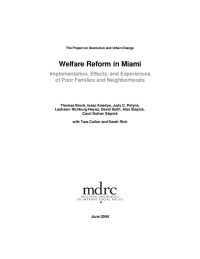Welfare Reform in Miami
Implementation, Effects, and Experiences of Poor Families and Neighborhoods
The 1996 national welfare reform law introduced a five-year time limit on federally funded cash assistance, imposed tough new work requirements, restricted benefits for noncitizens, and gave states more flexibility to design their welfare programs than in the past. Anticipating that the law might pose particular challenges for urban areas — where poverty and welfare receipt are concentrated — MDRC launched a study to examine its implementation and effects in four big cities. This report focuses on trends in Miami-Dade County between 1996 and 2002.
Key Findings
- Miami-Dade implemented a stringent program. Florida’s welfare reform went beyond federal law by imposing a relatively short, two- or three-year time limit on benefit receipt and by cutting off all cash assistance when adults failed to comply with work requirements or other rules. However, to encourage work, Florida’s reform also allowed welfare recipients to keep more of their earnings without losing welfare eligibility. Miami-Dade enforced the work requirements strictly, despite recurring problems in managing and delivering services to help people become employed. Far more families were cut off welfare because of noncompliance with work rules than because of time limits.
- Miami-Dade’s welfare rolls fell sharply, but how much of the decline was due to welfare reform is unclear. Between 1993 and 2002, Miami-Dade’s welfare caseload dropped by 75 percent as families both left welfare at a faster rate and came onto the rolls more slowly. A review of county welfare records found that these trends began well before 1996 and continued unabated thereafter, making it difficult to discern whether welfare reform had any effect. It may have reinforced trends that were already in place, or it may have affected people's behavior in new ways that the research could not detect.
- Welfare reform appears to have led to an increase in employment among welfare recipients. An analysis of welfare and employment data revealed that, after 1996, there was a sudden and significant increase both in the percentage of welfare recipients who became employed and in the duration of their employment. The county’s heavy reliance on financial penalties to enforce work rules, along with the state's policy to allow welfare recipients to keep more of their earnings when they went to work, seemed to be driving these results. The finding on increased employment is more reliable in the years just after 1996 than in later years, when it is less clear what would have happened if welfare reform had not occurred.
- Over time, welfare recipients’ employment and economic circumstances generally improved. A sample of nearly 600 women who received welfare shortly before the implementation of welfare reform was interviewed in 1998 and again in 2001. Most reported that they had exited welfare, started working, and increased their income — a pattern that might be the result of women and their children getting older, a strong economy, welfare reform, or all three. In general, the women earned low wages. Only one in four had a job that paid $7.50 or more per hour and provided health insurance. Nevertheless, the women tended to be better off financially than they were on welfare, particularly if they took advantage of the Earned Income Credit. Ethnographic interviews with 42 women suggest that they struggled to stay employed despite personal problems and poor work conditions, but the women often felt that even a bad job was better than a welfare system that they felt was punitive and disorganized.
- Neighborhood conditions remained stable or improved. Many critics of welfare reform feared that restrictions on welfare benefits would devastate poor communities, but an analysis of social and economic indicators in Miami-Dade from 1992 through 2001 does not support this conclusion. Both countywide and in the poorest neighborhoods, there were substantial declines in the teen birthrate, infant deaths, child abuse and neglect, and violent crime. Property crime declined slightly. The number of babies born with a low birth weight remained stable. These trends generally predated welfare reform and did not show major changes after 1996.
MDRC has released reports on welfare reform in Cleveland and Philadelphia and will publish a report on Los Angeles by early 2005.







